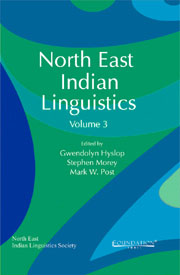14 - Derivational Morphology Compounding in Pnar
from Austroasiatic
Published online by Cambridge University Press: 26 October 2011
Summary
Introduction
This paper presents a description of the derivational morphology and the process of compounding in Pnar, an Austro-Asiatic language of the Mon- Khmer branch spoken in the Jaintia hills of Meghalaya. Derivational processes in Pnar are prefixing in nature and result with the formation of new words along with a change in lexical category. The notable derivational prefixes are noŋ-, i- and jiŋ-.
An attempt has been made in §2 of this paper to provide a brief linguistic description of Pnar. §3 discusses the nature of the derivational prefixes used in this language to derive new words. The next section of this paper is devoted to the causatives in Pnar which are morphologically realized. In §5, I discuss the poly-functional nature of the prefix wa- in Pnar as it is assigned the role of adjectivalizer, complementizer and conjunction although this prefix as a derivational morpheme is attached exclusively with adjectives. The next section analyses reduplication in Pnar as a derivational process. This language exhibits the instances of complete word reduplication which can be interpreted under the purview of derivational morphology. The process of compounding plays a vital role in the word formation process in Pnar which is discussed in detail with adequate examples in §7 of this paper.
As far as the methodology of this paper is concerned, it is based on primary data collected from three consultants. All the consultants are from Jowai, the region in Jaintia hills where Pnar is mainly spoken.
- Type
- Chapter
- Information
- North East Indian Linguistics , pp. 241 - 253Publisher: Foundation BooksPrint publication year: 2011

